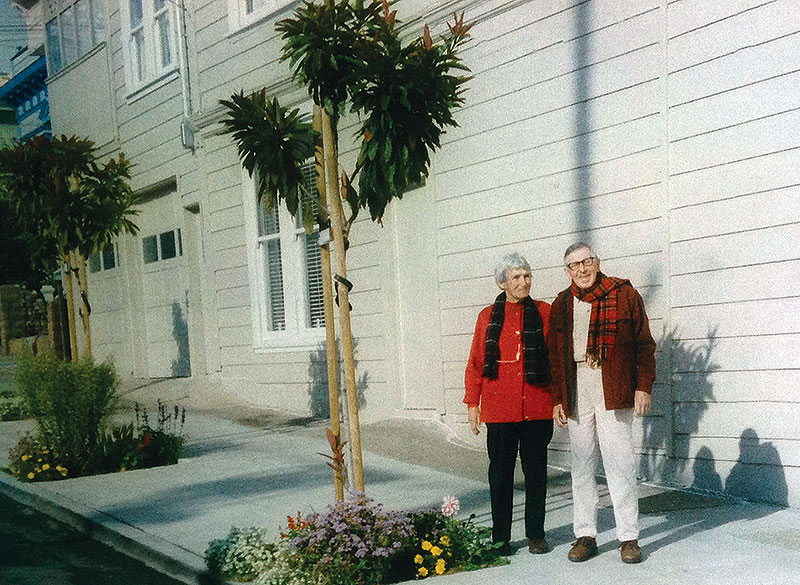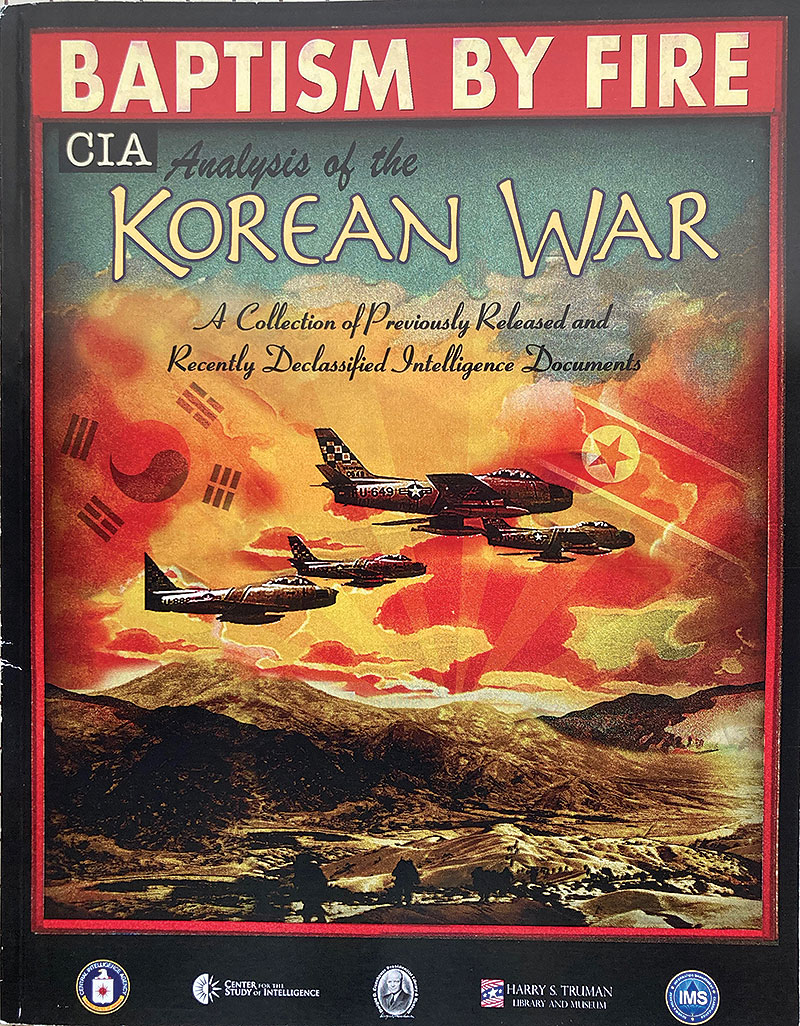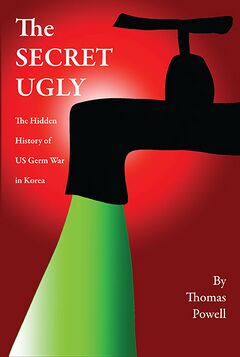Bill Powell Exposes Post-WWII US-Japan Germ War Deal
Historical Essay
by Tom Powell
Sylvia and Bill Powell in front of their home in San Francisco, c. 2000.
Photo: Powell Family Archives
The mistrial ended the immediate ordeal for my parents and gave them their lives back. Bill and Sylvia Powell settled into a much calmer life following the dismissal of the sedition charges. Sylvia went to work for the San Francisco Unified School District as an elementary school secretary. Bill continued the renovation business which included a couple of apartment buildings in Oakland. We moved across the Mission District to Bernal Heights, and in 1963 to Noe Valley and a nine-room corner flat on Church St. above a storefront. Bill was tired of plumbing and painting so he and Sylvia set up a new business, Homes of Charm Antiques. Antiques and Americana were things they loved.
On our frequent family camping trips traveling the back roads of California in our Volkswagen truck, we would detour to visit ghost towns and county dumps. Invariably we’d come home with treasures, enameled spittoons, bentwood chairs in need of caning, sometimes larger pieces, a bin table, a carved headboard, a Wedgewood stove even! So we had acquired an inventory that packed our garage. Bill would clean up these artifacts and put them for sale in the store window.
Annie Cook worked for Bill in the antique shop downstairs from our Noe Valley flat. Bill and Sylvia had started Homes of Charm Antiques in 1964 when Bill had had enough of the heavy lifting of house renovations. The shop specialized in Americana furniture, brass hardware and Victorian chandeliers. Annie polished brass and rewired chandeliers and handled sales when Bill was away. One day in 1971, the two of them were sitting in the pair of antique barber chairs and looking out the front windows onto the streetcar activity of Church St. while taking their usual afternoon tea break.
An older gentleman approached the store and entered. Bill took one look at him and did a double take. He got very fidgety, jumped up, and not quite knowing what to do with himself, ended up behind the counter. Bill was usually relaxed and easygoing. Annie had never seen him in such an agitated state. The older fellow made a round of the store aisles and headed towards the front door. As he was exiting he turned to say good bye. Bill looked straight at him and said, “You don’t recognize me, do you?” The man looked quizzically at Bill for a moment and said, “No, I don’t. Who are you?” Bill answered, “I’m John Powell.” The man said, “Oh! Oh, oh, I see.” He paused for a minute while they stared at each other. Then he walked over to the counter and stuck out his hand. Bill pondered for a moment, and then shook the man’s hand. The older guy fumbled a bit, “Well, I’ve got to go. Nice to see you again.” He turned and hurriedly left the store. “Who was that?” Annie asked breathlessly when the man had hastily crossed the street. Bill replied, “That was Judge Goodman.”
Eleven years had passed since Bill stood on trial in Goodman’s courtroom. Much had happened in his life since then. Both his parents were dead and so were Sylvia’s parents, John and I were adults and flown and Cam was starting high school. They had bought, fixed up and sold sixteen properties in San Francisco and Oakland, and now the antique store was beginning to show a profit. They had an active social life among their educated left-wing friends throughout the Bay Area. It was a good time to start planning their future.
Bill was still several years from retirement but I think Judge Goodman’s unexpected visit was an early catalyst for him to begin planning his comeback. Bill was short in height and wore glasses and was a peaceful man in part for that, but he was principled, and he would not have shook hands with [prosecutors] Schnacke or Carpenter if he had happened upon either of them. Goodman’s role was really only that of referee. He was a conservative judge in his political views, but he turned out to be a strict constitutionalist. He would not allow the prosecution to cheat the rules, and that benefitted the defense.
In 1977 Bill retired from selling antiques to pursue research and writing. Using the Freedom of Information Act (FOIA), he was able to amass thousands of pages of archival documents from the Army Chemical Corps, Fort Detrick, the National Archives, and other government sources. In two seminal articles he reopened the whole sordid germ war affair once again. The first article, “Japan’s Germ Warfare: The US Cover-up of a War Crime” was published in 1980 in the obscure, Bulletin of Concerned Asian Scholars. The second article, “A Hidden Chapter in History,” was published in the prestigious, Bulletin of the Atomic Scientists in October 1981.
In these articles Powell detailed the Japanese BW program in WWII located in a factory disguised as a water purification plant near Harbin, China. He outlined the gruesome experiments conducted on “maruta” or human “logs” by Unit 731 under the direction of Gen. Ishii Shiro, Axis Japan’s Dr. Mengele. He further revealed how Ishii and his top staff had fled Harbin after the war and successfully parlayed their BW research to General MacArthur in Tokyo in exchange for amnesty from war crimes prosecution. The extensive Japanese research was quietly transferred to Fort Detrick, the US Army’s secret bio-weapons research lab at Frederick, MD.
The story “went viral” for its day. Powell had once again succeeded in pulling the lid off the ugly stench of top-secret US BW operations. Exposing the war atrocities of Unit 731 and the US complicity in the war crimes cover-up was sweet vindication. However, in a 1982 interview with Morley Safer on 60 Minutes, Powell admitted that after a 7-year records search and 20,000 declassified documents reviewed through the Freedom of Information Act (FOIA), he had not been able to turn up the “smoking gun” evidence which would conclusively prove that the US had used BW in Korea. In the intervening years since the trial, government censors had diligently scrubbed the records erasing the incriminating paper trail.
Postscript
The release of Baptism by Fire is the long anticipated smoking gun. The CIA’s own internal documents narrate the struggle of North Korea and China to defend themselves over a period of 26 months from the US germ war assault. With the voluminous quantity of facts and details already uncovered by scholars, this document trove finally proves conclusively that the US did engage in a large-scale, sustained campaign of biological warfare in 1952 and 1953. These charges can no longer be labeled as 'alleged.' With the 2019 released COMINT documents the US government has unwittingly confessed to the use of biological warfare in the Korean War. It can now be established as historical fact.
Baptism by Fire: CIA Analysis of the Korean War This stylish noir commemorative brochure and CD set celebrated the release of 1300 recently declassified intelligence documents which inadvertently document the COMINT history of the Chinese and North Korean response to the US germ war campaign over a two-year duration. This is the long sought “smoking gun” evidence.
Baptism by Fire was produced as a glossy propaganda portfolio. The graphics are sexy and resemble 1950s noir period pieces. The 1300 documents are intended to showcase the range and penetration of CIA global surveillance, and the sophistication of its analysis. The portfolio is an institutional self-congratulatory publication by a younger generation of archivists. Security precautions became lax because the early Cold War is now ancient history.
This account is excerpted from The Secret Ugly: The Hidden History of US Germ War in Korea by Thomas Powell, Edgewater Editions: 2023.



